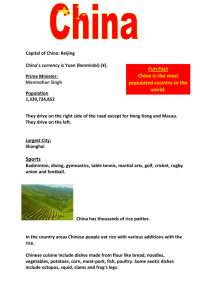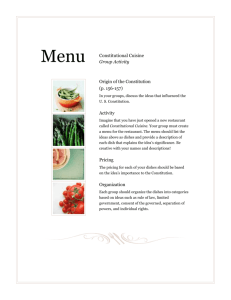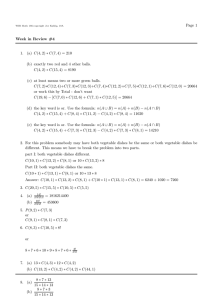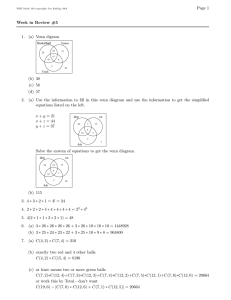Large Dishes from Jingdezhen and Longquan around the World Dr Eva Ströber
advertisement
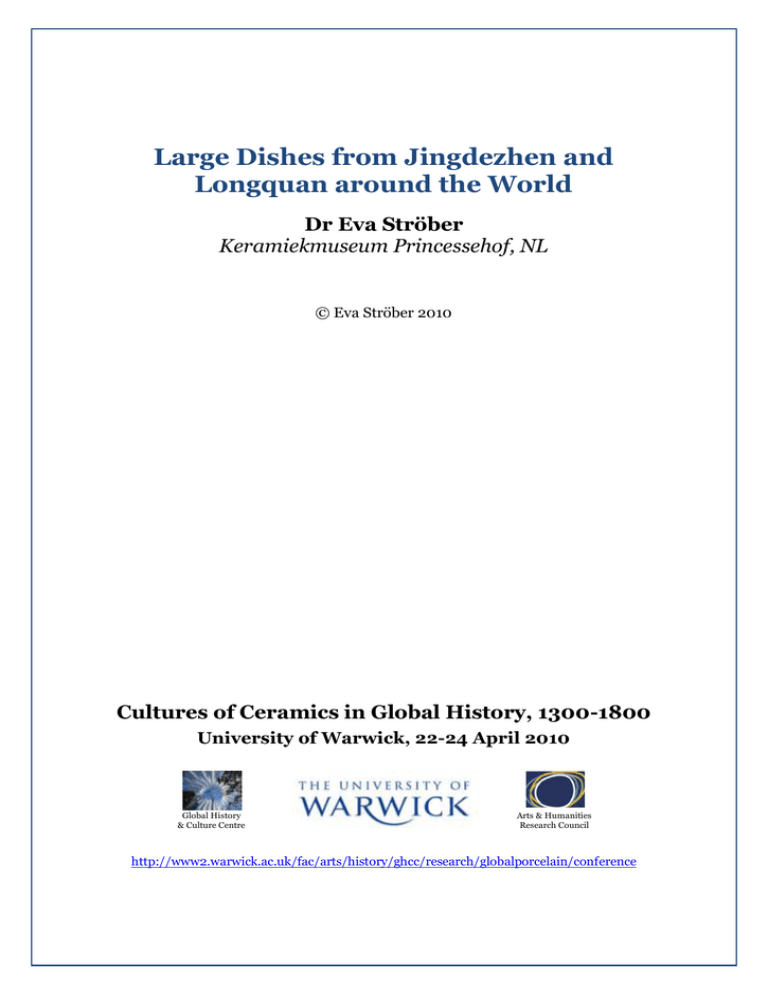
Large Dishes from Jingdezhen and Longquan around the World Dr Eva Ströber Keramiekmuseum Princessehof, NL © Eva Ströber 2010 Cultures of Ceramics in Global History, 1300-1800 University of Warwick, 22-24 April 2010 Global History & Culture Centre Arts & Humanities Research Council http://www2.warwick.ac.uk/fac/arts/history/ghcc/research/globalporcelain/conference Large Dishes from Jingdezhen and Longquan around the World The talk will be about the huge success of a type of Chinese porcelain the Chinese themselves had indeed no use for: large serving dishes, large meaning more than 35 cm in diam. The most common blue and white type was made in Jingdezhen, the Celadon type in the Longquan kilns in Southern Zhejiang and Northern Fujian. Another type of large dishes, the Zhangzhou type, was produced in the kilns of Zhangzhou, Fujian. The focus will be on three markets these oversized dishes were made for: the Muslim markets of the Middle East, particularly Persia, Turkey and the Mughal empire, SE Asia including what is now Indonesia, and Japan. By miniatures, drawings, paintings or old photographs it will be illustrated, how these large Chinese dishes were used in a non Chinese social and cultural context. The Chinese Bowl The Chinese themselves, as can be seen on the famous painting of a literati gathering from the Song – dynasty of the 12th century, dined from rather small sized tableware. The custom to eat from small dishes and particularly from bowls started in the Song dynasty and spread to many countries in SE Asia. It has not changed even to this very day. The classical, quintessential medium sized bowl is one of the greatest inventions of Chinese genius. A multipurpose vessel for rice and noodles, vegetables, meat and soup. The Chinese actually never felt any need for large dishes. The Muslim Market for large dishes In the Yuan dynasty of the 13th century, when the global market opened, Jingdezhen and Longquan started to produce large dishes for the Middle East Muslim market. The large Muslim community in Quanzhou, Fujian province, and the growing export market stimulated the production of blue and white porcelain in Jinghdezhen and of celadon in Longquan much of which was shipped or transported by land routes to the Islamic countries of the Middle East by Persian traders. An album painting from Samarkand, dated in the beginning of the 15 th century, depicts a caravan travelling through the desert with a cart full of blue and white Chinese porcelain. The painting symbolizes the opening or rather reopening of the international travel routes under the Ming emperors Yongle (1403- 1424), and Xuande (1426 – 1435). The designs on the blue and white porcelain could very well reflect Xuande decors. Blue and white large dishes, like the one from the collection of the Rijksmuseum Amsterdam, dated into the 14th century and of a diameter of 46 centimeter, would be typical for of the kind of large blue and white dishes made in Jingdezhen for a Middle East Muslim market and is found in numbers in the still existing great collections of the Middle East, the Topkapi Saray in Istanbul and the Ardebil Shrine in Persia. Ottoman Turkey In Turkey, the Ottoman empire, which lasted from the end of the 13 th century to 1922, as well as in Persia and the Mughal court, these large dishes made in China were used as serving dishes. This can be seen on a 14 th century painting, which depicts the Turkish sultan, probably Murad I, with his guests at a banquet. A huge Chinese blue and white dish piled high with what looks like a delicious pilaf sits in the centre of the table. Each guest holds a spoon to serve himself from the large dish the traditional way people share a meal in Islamic countries. The way Chinese porcelain was used at banquets did not change much in later centuries, as can be seen from a miniature depicting the reception of the Polish ambassador at the Ottoman court at the Topkapi Saray in 1677. Members of the cabinet and the most important visitors sit in small, hierarchically organized groups around trays placed on low stands. The food was served one course at a time. There was one large dish for each table and the guests served themselves with wooden spoons. One of the largest collections of Chinese porcelain from Jingdezhen and Longquan made for the Middle East market is the collection in the Topkapi Saray in Istanbul. The Ottoman rulers were using Chinese porcelain as luxury tableware. A huge percentage of the more than 20 000 pieces preserved are large serving dishes. Among them are an important collection of 14th century blue and white porcelain made in Jingdezhen and more than 1350 pieces of celadon. We know from descriptions that at some formal banquets more than 800 pieces of celadon were used. Food at ceremonial banquets at the Topkapi was mostly served on celadon dishes, as celadon was believed to crack or “sweat” if poisonous food was placed on it. Besides being used as tableware large celadon dishes served as diplomatic gifts not only between Middle East rulers, but were also given to European courts. A large celadon dish was given in the year 1487 from the Egyptian sultan Qa’it Baj to Lorenzo de Medici, documented by the inscription on the bottom of the dish. Mughal empire Large Chinese dishes of the blue and white Jingdezhen type are frequently found on Mughal paintings or miniatures. A descendant of Ghengis Khan, Timur, founded around 1400 the powerful Central Asian Timurid empire with its capital Samarkand. The Timurid rulers were fervent Muslims and embraced Persian culture and language. When it came to ceramics, they imported blue and white from China or tried to imitate it. A Timurid prince, Babur, conquered in the beginning of the 16 th century the Indian Subcontinent and in 1526 founded the Mughal Empire. It is not surprising to see Chinese blue and white large dishes on Mughal miniatures depicting Mughal court life, showing their high status in use as tableware to serve food at official banquets. Many Mughal paintings from the 16th to the 18th century depict royal banquets, with lots of pilaf and meat piled up and served from large Chinese celadon or blue and white dishes. A miniature, dated 1598, shows Babur in the company of Uzbek and Hindu envoys at a banquet. The large dishes in front of the ruler and in front of the guests in the foreground are of the familiar blue and white type from Jingdezhen. But it seems that in this case the dishes were not used to serve food, but to clean hands before eating. Persia Persia was a great market for large Chinese porcelain dishes starting in the Yuan dynasty. They were luxury goods, collected and used by the Persian rulers and the elite. A most important collection of Chinese porcelain is preserved in the Ardebil Shrine. This collection was formed differently from the Topkapi collection. Shah Abbas, the great Persian ruler, dedicated in 1611 a collection of Chinese ceramics to the mausoleum of his ancestor. To this Shrine, Ardebil, far from Isfahan and located near the Caspian Sea, belonged a mosque, tombs, lodgings for pilgrims and kitchens. Most of the 805 pieces of porcelain are blue and white, made in Jingdezhen from the 14th to the 16th century, plus some 50 celadons, mostly large dishes. We do not have a visual documentation how these pieces were actually used in the shrine. But the rooms, where the Chinese porcelain was stored and displayed, have been preserved. The chini-kane at the Ardebil Shrine, a “China room”, is actually the first “porcelain cabinet”. The niches were made especially to display and store the vessels of Chinese porcelain used to entertain important guests and pilgrims. Most of the pieces, when they entered the Ardebil shrine, were marked with an incised or drilled so called vaqfnahmeh, a dedicatory inscription by Shah Abbas. 94 pieces have an inscription with the name of Quarachagay Khan, an Armenian Christian, a high ranking official. His portrait is on a miniature from Isfahan, dated 1620 – 1625. It seems, that he had collected the Chinese blue and white traded on the market in Isfahan, and had these pieces marked with his name. Out of loyalty he gave his collection to Shah Abbas, and the collection entered the Ardebil Shrine. Indonesia The second market for large Chinese dishes to focus on is SE Asia, particularly what is now Indonesia. There was a very early trade, with associated diplomatic missions and shipping, first documented for the 5th century, when two Buddhist monks travelled from Java to China, one of them Gunawarman, a Kashmir prince, on a diplomatic mission invited by the Chinese emperor Wendi (424 453). Chinese sources from the 12th and 13 th century inform us, that “…of all wealthy foreign lands which have great store of precious and varied goods, none surpasses the realm of the Arabs (Tashii). Next to them comes Java (Shepo), the next is Palembang (Sanfoqi). Palembang, in the Southern part of the island of Sumatra, was an ancient Buddhist kingdom of Srivijaya, which controlled between the 8th and the 13th century major parts of what is now Malaysia and Indonesia. Trade between Indonesia and China would be carried on Persian, Indian, and, of course, Chinese ships. Chinese ceramics – in exchange for spices - were some of the most important trade goods. Large dishes, of the Celadon or the blue and white type, made from the 14th century onward, are found in Indonesia in considerable numbers. The way Chinese porcelain was appreciated in Indonesia can be seen on this photograph, taken in the 1920th. The gentleman in the middle proudly holds a huge and probably very heavy Longquan Celadon dish. The gentleman on the left is holding what seems like a huge blue and white Ming double gourd vase, and the huge vase on the right could be a blue and white Kangxi piece. “Antique” Chinese ceramics were highly appreciated in Indonesia, where they were regarded as precious heirlooms and were passed from generation to generation. They were used at important rituals such as childbirth, weddings and funerals, for fertility rites and official representation. These ritual dishes for offering rice and used for very special occasions were called piring bersama – communal dishes. The ritual use of large dishes can be seen from in a Dutch book on Borneo from the middle of the 19th century. It depicts a nightly ritual with the Dayaks for a sick person. The shaman dances and falls into a trance beneath an ironwood tree. In the centre of the ceremony are the offerings: a jar and several large celadon dishes filled with rice. The courts in Solo, Yogyakarta and Cirebon still use Chinese or foreign ceramic dishes for rituals. A photograph taken at the court of Solo on Java in 1979 shows a ceremony commemorating the birth of Mohammed. The Solo heirloom dishes are used only for this occasion and are reserved for the inner court. Attendants make a total of 8 dishes, filled with rice or white cloth. All dishes were used, and said to be owned, by the sultan Agung, who reigned in the first part of the 17th century. Besides large celadon dishes Zhangzhou dishes with Arabic or rather pseudo Arabic inscriptions were also used. Japan The third big market for large Chinese dishes was Japan. This sounds surprising at first. Looking into the history of the role of utensils used in Japanese eating habits, for a long period of time people ate from bowls and small dishes served on individual dining trays. Thus the use of large dishes for dining seems to have been unnecessary, the same way it was in China. But it is documented in old Japanese collections, on paintings and by excavations, that large dishes of the blue and white and the celadon type, the Kraak and the Zhangzhou type were exported from China to Japan. One of the earliest depictions of a large Chinese celadon dish in Japan is on a hand scroll from the 15th century, Muromachi period, from the Idemitsu Museum, Tokyo, the Fukutomi zoshi. The large celadon dish, filled with fruit, together with other utensils made of lacquer work seemed to be displayed as status symbols of a rich man. From around 1600 onwards, large dishes began to become popular with the aristocracy and the new wealthy urban elite. The growing popularity of this type of dishes in Japan can probably be attributed to the world-wide boom of this style of dishes that was largely being produced for export in the kilns of Jingdezhen and southern China during the 16th and 17 th century, and imported into Japan by the Portuguese and the Dutch. Portuguese traders arriving in Japan with ships laden with – Chinese – ceramics are depicted on the so called Namban screens. On Japanese genre paintings from the 16th to the 18th century large dishes can frequently be seen in depictions of luxurious banquets and gatherings as an important part of showing off, of a fashionable life style. This style was called teinai yurakuzu – “pleasures in the mansion”. The paintings depict lavish parties, with beautiful ladies in richly decorated kimonos, exquisite lacquer wares, large and fanciful ceramic dishes and choices of extravagant food. From the middle of the 17th century it becomes difficult to decide if these vessels are Chinese or Japanese. The Japanese had started their own production of large dishes, celadons made in the Mino kilns in imitation of Chinese Celadons from Longquan, and the large dishes decorated in the specific colors and motifs of the Kutani-style. Three large dishes Three interesting pieces from the collection of the Princessehof Museum in Leeuwarden reflect the inner Asian trade – China, Japan, Indonesia- in large dishes in the 17th century. A Ko – Kutani dish of a diameter of 43 cm was made in Japan in the middle of the 17th century and was acquired for the Netherlands in the beginning of the 20th century in Indonesia. By the way: Almost all the large Chinese and Japanese Celadon dishes preserved in Dutch collections were found not in China or Japan, but in Indonesia. Not only China, but Japan too, traded large dishes to Indonesia. The brilliant Zhangzhou dish, painted in bright turquoise and red, and of a diameter of 37cm, was made in China, in the Zhangzhou kilns of Fujian. Excavations and preserved pieces in old Japanese collections suggest that these large dishes were made for the Japanese market. Chinese Zhangzhou dishes, as can be seen from a very rare piece, were also imitated in Japan. A dish of a diameter of 37 cm was made in the kilns of Yoshida at around 1650. The red seals are “quotations” from the Chinese model, the chrysanthemum shape, the decoration with a lion and peonies and the color scheme, which is related to Kutani wares, very Japanese. It seems that in the West we did focus too long only on the trade and the cultural exchange going on between China and Europe or China and the West, and did not realize that there were many more, and in fact more important, “global” markets for the Chinese porcelain trade. The story of the large dishes shows, how the potters in Jingdezhen and Longquan from the Yuan dynasty onward had developed a new and most successful export “global” product for new markets. There were no real commissions for large dishes; there were no trading companies or enterprises comparable to the Portuguese and Dutch East India companies in the Ottoman empire or in Persia, in Indonesia or in Japan. Still, trade in large dishes flourished. This conference will be great step forward in understanding the underlying structures of trade and exchange and will expand our ceramic horizons.
